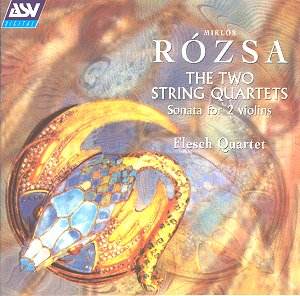Miklós Rózsa’s undisputed reputation
as a composer of substantial film scores has often obscured his remarkable
achievement in the field of pure, abstract music. Throughout his busy
career in Hollywood, he managed to compose a sizeable body of substantial
concert works. Over the last ten years or so, many of his major orchestral
works, including his superb concertos, have been recorded . The credit
then went to KOCH. Now, ASV fill an important gap in Rózsa’s
discography with the present recordings of his string quartets and of
his Sonata Op.15a for two violins.
In the early 1930s, Rózsa composed a string
quartet of which he later banned any performance or publishing though
the complete score exists in the archives deposited at the University
of Syracuse. (Curiously enough Rózsa allotted the same opus number
[Op.6] to his masterly symphony completed in 930.)
So, Rózsa’s official String Quartet No.1
Op.22 was completed in 1949 and revised in 1950. It is a substantial,
ambitious work in four sizeable movements of which the slow movement
Lento is the emotional core. This impassioned meditation was
later scored for string orchestra by the late Christopher Palmer under
Rózsa’s supervision (available on KOCH 3-7152). The first movement,
a set of variations rather than the customary sonata-form shape, is
followed by a nervous Scherzo in modo ongarese in which the composer’s
Hungarian roots are clearly evident. The First String Quartet finishes
with a lively Rondo alternating an angular first subject and a more
lyrical second subject, and ends with an exalted coda.
Written thirty years later, the String Quartet
No.2 Op.38 is clearly a mature work in which the material, still
recognisably Rózsa and Hungarian, is more intricately developed.
The quartet’s four highly characterised movements are closely thematically
related, and the work as a whole has a greater structural and thematic
coherence than its companion. Again, the playful Scherzo, placed third
this time, is All’Ungherese. By the time the Second String Quartet
was composed, Rózsa’s formal mastery had reached its peak, and
the quartet’s musical argument is worked out with a sure hand. This
might well be one of Rózsa’s finest concert works.
The earlier Sonata for two Violins Op.15a,
composed in 1933 and revised in 1973 as Op.15a, is somewhat lighter
in mood. It sometimes recalls Bartok’s Duos, albeit on
a more substantial scale. This is a truly delightful work.
As far as I can judge, the Flesch Quartet’s performances
are excellent and are warmly recorded. The present release is a real
winner and is warmly recommended with the secret hope that ASV will
soon follow-up with a recording of some other chamber works by Rózsa,
such as the String Trio Op.1 and the Piano Quintet
Op.2.
Hubert Culot


